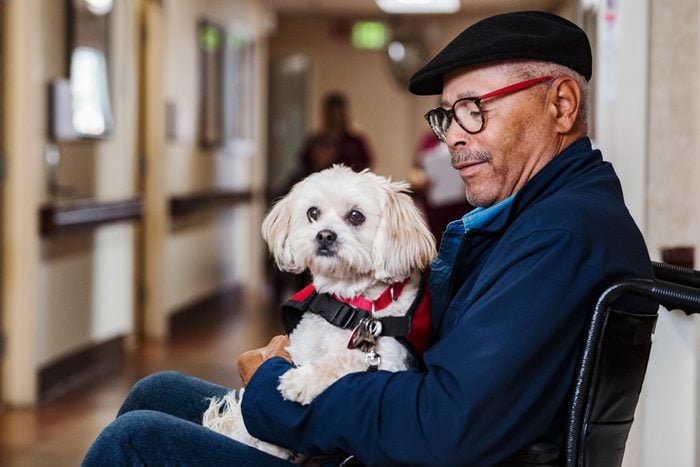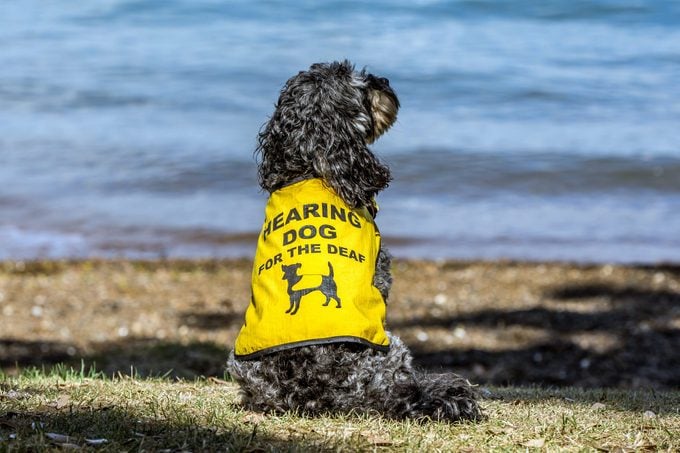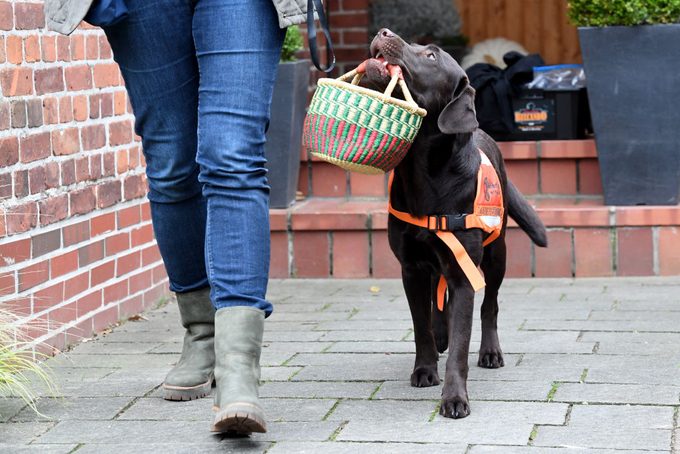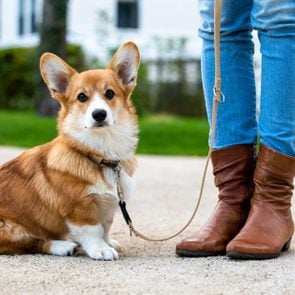8 Types of Service Dogs That Aid People in Need
Updated: Jan. 17, 2024

There are good boys, and then there are the types of service dogs that help tens of millions of Americans live better lives.
Your pup might be your most loyal friend, but to many, dogs are much more than loving companions. They play a vital role in helping around 80 million Americans as various types of service dogs. The Americans with Disabilities Act (ADA) defines a service animal as one that has been specifically trained to perform a task or action to help a person with a disability.
Although dogs have provided support to humans for thousands of years, the modern service dog movement began after World War I to assist returning soldiers who had been blinded in combat. But there are many types of service dogs beyond Seeing Eye dogs. These smart, capable canines provide all types of aid, from seizure alert and assistance to guide dog services, allergy detection, hearing assistance, and PTSD, autism, and emotional support. These fur heroes must be treated to a puppuccino now and then!
It can take years for animals to learn how to function in certain support roles, which is why dogs that are easiest to train, like Labrador and golden retrievers, are frequently used as service dogs. Other top contenders for service dog roles? Calm dogs and some of the smartest dog breeds, including golden retrievers and poodles. While you’re at it, also discover our list of the dumbest dog breeds.
Breeds that make the best service dogs
While any dog can be a therapy dog, some breeds are better suited to the task than others. An assistance dog should be:
- Calm
- Friendly
- Obedient
- Intelligent
- Able to adapt to new environments or routines
- Able to ignore distractions
Smart, calm, and loyal dog breeds tend to carry those traits, which is why they’re often tapped for service dog work. Size makes a difference for certain types of service dogs as well. Think about it: A toy dog breed won’t be able to brace a person with mobility issues, but a larger dog will. But smaller dog breeds can be useful for things like alerting people with diabetes of a drop in blood glucose levels.
Common types of service dogs include:
- Labrador retriever: easy to train, highly adaptable, enjoys mental stimulation
- Golden retriever: intelligent, easy to train, highly adaptable
- German shepherd: intelligent, easy to train, highly adaptable, enjoys mental stimulation
- Bernese mountain dog: calm, eager to please, loyal
- Poodle: intelligent, easy to train, enjoys mental stimulation
- Papillon: alert, easy to train, highly adaptable
- Great Dane: dependable, patient, strong and sturdy
- Saint Bernard: adaptable, eager to please, strong and sturdy
Types of service dogs
There are a number of ways service dogs assist and comfort their human companions. Most fall into one of the eight categories below.
1. Guide dogs
Out of all of the types of service dogs, guide dogs are perhaps the most well-known. These dogs assist visually impaired people with daily tasks, helping them safely move throughout their homes and public spaces with independence. The dogs help with tasks such as avoiding obstacles, crossing the road, walking safely, and finding doors.
As you can imagine, a lot of training is required for a dog to perform such complexities. The training process can take up to two years, with ongoing training throughout the animal’s working career. Labrador retrievers, German shepherds, and golden retrievers are often the best types of service dogs for guiding because they’re easy to train, smart, and have an even temperament. Incidentally, they’re also the top three most popular dog breeds.
2. Emotional support dogs
An emotional support dog provides support and comfort to someone with a mental health condition or disability, like depression or anxiety. For a pet to legally qualify as an emotional support animal, owners must first meet with a mental health professional, such as a psychologist, who will verify the condition and license the pet.
Any dog can be an emotional support pet, even small and medium dog breeds. The best apartment dogs, including pugs and greyhounds, are loving companion animals who always want to spend time with their humans, so they make great emotional support pets. They’re extremely loving and you won’t be able to stop yourself as you’d want to pick them up and cuddle with them.
While comforting companions have their place, know that there’s a difference between emotional support animals and service animals. Because emotional support dogs haven’t been trained to perform a task—a key element of a service animal—they’re not considered service dogs by the ADA and aren’t always allowed in many public places the way guide dogs are. Still, they play a vital role in offering support to those in need.
3. Allergy detection dogs
For people with severe allergies to foods like peanuts, an allergy detection dog can be a lifesaver. Dogs have around 300 million olfactory receptors in their noses (compared to our six million), which means they’re capable of tracking many scents, even in tiny amounts. Indeed, dogs can smell many things humans can’t.
Using reward-based training, these dogs learn to seek out a certain smell, such as peanuts, and alert their handler to the danger. These helpful pups can prevent anaphylactic shock or other severe allergic reactions.
4. Hearing dogs

A hearing dog can help those with hearing impairments live a normal life. They’re trained to associate a certain sound with a reward—a fun way for them to learn how to alert their humans to important sounds, such as a doorbell, alarm clock, or fire alarm.
They learn to act as ears for their handlers, but they also provide companionship, which is especially essential for elderly adults who may live alone. Labs and golden retrievers are often used for this job—they’re smart, easy to train, and devoted. And as an added bonus, golden retrievers are considered one of the best dogs for seniors.
5. Mobility assistance dogs
For individuals with disabilities that limit their movement—like those that require the use of a wheelchair—the help of a mobility assistance dog can be life-changing. These trained service animals might retrieve objects, help open automatic doors, carry bags, or provide balance for their handler when the person is walking. They’ve been trained to help people with disabilities such as spina bifida, arthritis, brain injuries, vertigo, and more.
Not all dogs are suited to this work. For a dog to provide balance for its owner, for instance, it needs to be a big dog that can handle the added weight. The best dogs for the job are smart, athletic in build, and easily trained. You’ll often see Labrador retrievers, golden retrievers, and standard poodles performing this service.
6. Autism support dogs
For adults and children with autism, a support dog can play a vital role. These dogs are good with kids and are trained to assist someone with autism, most often a child, so that they feel safer and calmer, especially in unfamiliar environments.
An autism support dog can help a person with autism through their daily routine, provide a safe interruption during undesirable behaviors, help children sleep better, and even track a child who goes missing.
7. Diabetes alert dogs

People with diabetes need insulin to keep their blood sugar from getting too high, but blood sugar that’s too low poses its own risks. While blood sugar monitors are essential, some people supplement the device with a furry friend who can sniff out lows in time for their owner to be treated.
A diabetes alert dog—often a Lab, golden retriever, standard poodle, or mixed-breed dog, like a labradoodle—is trained using sweat samples from its owner with both normal and low blood sugar levels. Over time, the dog learns to alert its owner when it smells low blood sugar. Sometimes the dog will sniff out low blood sugar before its owner experiences (or notices) symptoms.
So how reliable are they? While some studies have shown that diabetes alert dogs can accurately sense low blood sugar, a 2019 study published in PLOS One notes that accuracy depends on the dog and its training. And in 2016, researchers reported in the Journal of Diabetes Science and Technology that the dogs aren’t as accurate as continuous glucose monitors. While diabetes alert dogs aren’t a substitute for regular blood sugar tests, they can give a person with diabetes peace of mind, help them worry less about their blood sugar levels, and help reduce the number of serious lows they experience.
8. Psychiatric service dogs
A psychiatric service dog, or PSD, has been trained to help someone with mental illness, including PTSD and schizophrenia. These pups perform specific tasks for their owners, allowing them to live more comfortably.
Because they have undergone specific training, psychiatric service dogs are different from emotional support animals, which don’t undergo any formal training.
How to get a service dog
If you’re considering getting a service dog, first think about the responsibilities and costs associated with pet ownership. Not only are dogs expensive to buy, but you’ll also shell out for dog food, veterinarian and groomer bills, and sometimes a dog walker. Dog ownership is a big commitment, so take the decision seriously.
Once you’re sure you’re ready, talk to your doctor, therapist, or mental health professional. They can advise you on the requirements to qualify for different types of service dogs. Here are a few resources to help you learn more:
- Assistance Dogs International
- American Kennel Club Recognized Therapy Dog Organizations
- Guide Dogs of America
Sources:
- American Kennel Club: “Service Dogs 101—Everything You Need to Know”
- Americans with Disabilities Act: “Frequently Asked Questions about Service Animals and the ADA”
- American Kennel Club: “Everything You Need to Know About Emotional Support Animals”
- PLOS One: “How effective are trained dogs at alerting their owners to changes in blood glycaemic levels?: Variations in performance of glycaemia alert dogs”
- Journal of Diabetes Science and Technology: “Reliability of Trained Dogs to Alert to Hypoglycemia in Patients With Type 1 Diabetes”
Next: Explore pet loss quotes for supporting a loved one when the worst happens.



